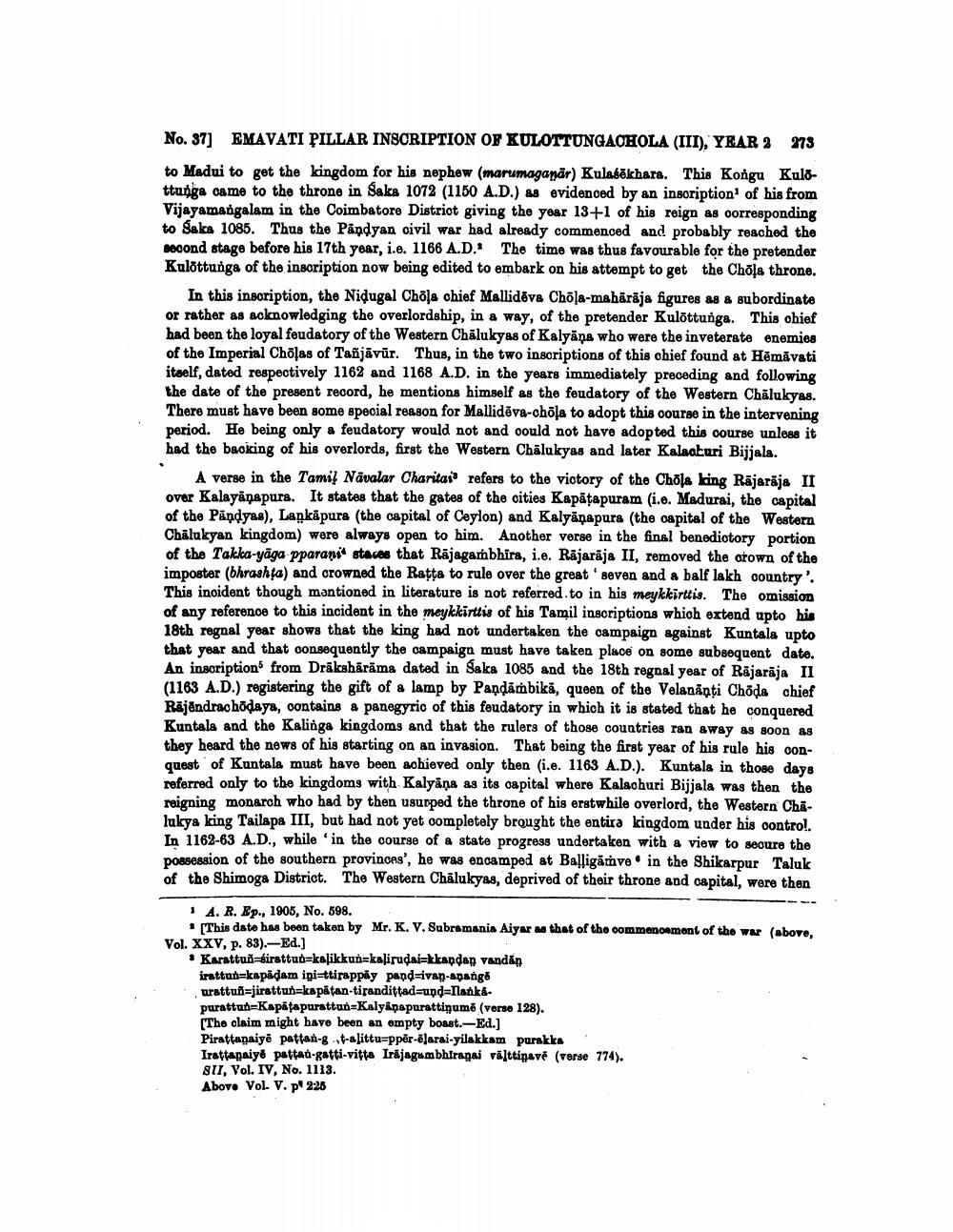________________
No. 37] EMAVATI PILLAR INSCRIPTION OF KULOTTUNGACHOLA (III), YEAR 2 273 to Madui to get the kingdom for his nephew (marumagapär) Kulabēkhara. This Kongu Kuldttunga came to the throne in Saks 1072 (1150 A.D.) as evidenced by an insoription of his from Vijayamangalam in the Coimbatore District giving the year 13+1 of his reign as corresponding to Saka 1085. Thus the Påndyan civil war had already commenced and probably reached the moond stage before his 17th year, i.e. 1166 A.D. The time was thus favourable for the pretender Kulottunga of the inscription now being edited to embark on his attempt to get the Chola throne.
In this inscription, the Nidugal Chola chief Mallidēva Chola-mahārāja figures as a subordinate or rather as acknowledging the overlordship, in a way, of the pretender Kulottunga. This chief had been the loyal feudatory of the Western Chalukyas of Kalyāṇa who were the inveterate enemies of the Imperial Choļas of Tañjāvūr. Thus, in the two inscriptions of this chief found at Hēmăvati itself, dated respectively 1162 and 1168 A.D. in the years immediately preceding and following the date of the present record, he mentions himself as the feudatory of the Western Chalukyas. There must have been some special reason for Mallidēva-chõla to adopt this course in the intervening period. He being only a feudatory would not and could not have adopted this course unless it had the baoking of his overlords, first the Western Chalukyas and later Kalaskuri Bijjala.
A verse in the Tamil Nävalar Charitas refers to the viotory of the Chola king Räjaräja II over Kalayanapura. It states that the gates of the cities Kapāțapuram (i... Madurai, the capital of the Pandyas), Lankapura (the capital of Ceylon) and Kalyanapura (the capital of the Western Chalukyan kingdom) were always open to him. Another verse in the final benedictory portion of the Takka-yāga pparans staces that Rājagambhira, i.e. Rājarāja II, removed the crown of the imposter (bhrashfa) and crowned the Ratta to rule over the great 'seven and a balf lakh country'. This incident though mantioned in literature is not referred to in his meykkirttis. The omission of any reference to this incident in the meykkirttis of his Tamil inscriptions which extend upto his 18th regnal year shows that the king had not undertaken the campaign against Kuntala upto that year and that consequently the campaign must have taken place on some subsequent date. An inscription from Drākehāräms dated in Saka 1085 and the 18th regnal year of Rajarāja II (1163 A.D.) registering the gift of a lamp by Pandāmbikā, queen of the Velanånti Choda chief Räjändrachödaya, contains a panegyric of this feudatory in which it is stated that he conquered Kuntala and the Kalinga kingdoms and that the rulers of those countries ran away as soon as they heard the news of his starting on an invasion. That being the first year of his rule his oonquest of Kuntala must have been achieved only then (i.e. 1163 A.D.). Kuntala in those days referred only to the kingdoms with Kalyāna as its oapital where Kalachuri Bijjala was then the reigning monarch who had by then usurped the throne of his erstwhile overlord, the Western Chilukya king Tailapa III, but had not yet completely brought the entira kingdom under his contro!. In 1162-63 A.D., while in the course of a state progress undertaken with a view to secure the possession of the southern provinces', he was encamped at Balligarve in the Shikarpur Taluk of the Shimoga District. The Western Chalukyas, deprived of their throne and capital, were then
1 A. R. Ep., 1905, No. 598.
[This dato has been taken by Mr. K. V. Subramanis Aiyar ma that of the commononment of the war (abovo, Vol. XXV, p. 83).-Ed.]
• Karattua-kirattutkalikkun=kalirudaikkandap vandáp irattad-kapadam ipi=ttirappay pand=ivan-spango urattu=jirattun-kapātan-tirandittad=und=Ilankapurattu-Kapätapurattun-Kalyanapurattinumo (verse 128). [The claim might have been an empty boast.-Ed.) Pirattanaiyo pattan-
gt-alittu=pper-laral-yilakkam purakka Irattapaiyo pattad-gatti-vitta Irājagumbhirapai välttinave (varse 774). SU, Vol. IV, No. 1113. Above Vol V. p 225




